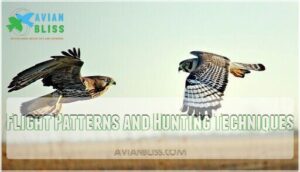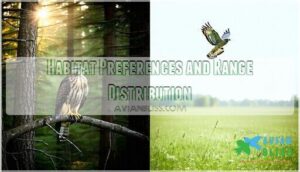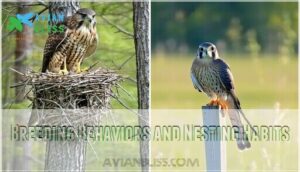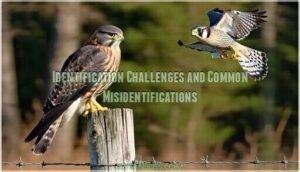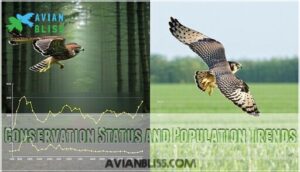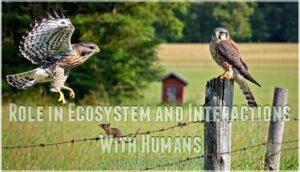This site is supported by our readers. We may earn a commission, at no cost to you, if you purchase through links.
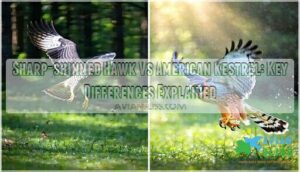
Sharp-shinned hawks, smaller forest raptors, showcase short, rounded wings and a long, squared tail perfect for zipping through trees. They’re built for surprise attacks and mostly hunt small birds.
Kestrels, on the other hand, prefer open fields and are famous for their fluttering hover as they scout for insects, rodents, or lizards. Sporting colorful plumage, including males’ striking blue-gray wings, kestrels are visually stunning.
While sharp-shins rely on agility, kestrels are masters of strategy, hovering like aerial acrobats.
Spotting one? Look for habitat clues and their distinct hunting styles.
Table Of Contents
- Key Takeaways
- Distinct Physical Characteristics of Sharp-shinned Hawk and Kestrel
- Flight Patterns and Hunting Techniques
- Habitat Preferences and Range Distribution
- Vocalizations and Communication Methods
- Breeding Behaviors and Nesting Habits
- Identification Challenges and Common Misidentifications
- Conservation Status and Population Trends
- Role in Ecosystem and Interactions With Humans
- Frequently Asked Questions (FAQs)
- How can you tell if a hawk is sharp-shinned?
- How do you identify an American Kestrel?
- Is an American Kestrel a sparrowhawk?
- Which is bigger, Cooper’s hawk or Sharp-Shinned Hawk?
- How can you tell an American kestrel?
- Is an American kestrel a sparrowhawk?
- Is a sparrowhawk the same as a Cooper’s hawk?
- What is the difference between sharp-shinned hawk and kestrel?
- How can you tell if a hawk is Sharp-shinned?
- What is the difference between a sharp-shinned hawk and an Cooper’s hawk?
- Conclusion
Key Takeaways
- You’ll notice sharp-shinned hawks hunt small birds in forests using stealth and quick maneuvers, while kestrels hover over open fields targeting insects and small mammals.
- Sharp-shinned hawks have stocky builds, short rounded wings, and square tails, whereas kestrels display slender frames, vibrant plumage, and long narrow tails.
- Kestrels stand out with their bold facial stripes and hovering skills, while sharp-shinned hawks rely on ambush tactics for precision hunting in woodlands.
- Conservation efforts are crucial as habitat loss and climate change threaten both species; kestrels benefit from nesting box programs, while sharp-shinned hawks need intact forests.
Distinct Physical Characteristics of Sharp-shinned Hawk and Kestrel
When comparing the sharp-shinned hawk and the American kestrel, you’ll notice striking differences in size, shape, and plumage.
The hawk’s stocky build and squared tail contrast sharply with the kestrel’s slender frame.
The kestrel has bold face markings, and warm rusty hues.
Size Comparison
When comparing the sharp-shinned hawk and the American kestrel, size is a standout difference. Hawks range from 3-8 oz, while kestrels weigh a petite 4.1 oz. Their wingspans also vary, with kestrels reaching 22 inches. These weight differences and their impact on flight styles are striking.
- Kestrel: Slim build, robin-like size.
- Sharp-shinned Hawk: Stockier, longer tail.
Body Shape and Proportions
When looking at body proportions, the sharp-shinned hawk sports a compact, stocky build, while the American kestrel appears leaner and more agile.
A key difference is relative head size: sharp-shinned hawks have smaller heads compared to their body mass.
The slenderness comparison reveals the kestrel’s proportional, robin-like profile, ideal for swift dives.
Their body morphology highlights variations in wing shape differences and tail length variance, suiting their distinct hunting and flight styles.
Wing and Tail Structure
Wing and tail features set the sharp-shinned hawk and American kestrel apart.
- Wing Shape: Hawks have shorter, rounded wings; kestrels possess long, pointed ones.
- Tail Length: Hawks’ tails look squared when spread, kestrels’ are slender and narrow.
- Feather Patterns: Hawks boast strong tail banding; kestrels display subtler patterns.
- Flight Aerodynamics: Hawks glide unsteadily; kestrels hover with purposeful grace.
These hawks often inhabit dense coniferous forests, though they adapt to other environments.
Plumage Patterns and Coloration
Spotting the plumage patterns of these raptors feels like color coding in nature.
The Sharp-shinned Hawk sports a sleek blue-gray back with orange-barring across its chest and bold black-and-white tail bands, perfect for blending into woodlands.
The American Kestrel dazzles with rufous-brown upperparts and trademark black-stripped face markings, making it eye-catching in open fields.
Males and females across both species share distinctive field marks, though males often show lighter, crisper coloration.
Juvenile plumage leans browner, while seasonal changes barely touch these bold palettes.
Flight Patterns and Hunting Techniques
When you compare a Sharp-shinned Hawk’s quick, agile wingbeats to an American Kestrel’s graceful hovering, their unique flight styles become clear.
These differences aren’t just for show—they directly influence each bird’s hunting success and choice of prey.
Sharp-shinned Hawk’s Agile Forest Pursuits
The sharp-shinned hawk (Accipiter striatus) is a master of woodland stealth enhanced by superb aerial agility. It uses its compact wings and square-tipped tail to perform lightning-fast maneuvers through dense canopies, perfecting Forest Hunting Tactics.
Swift and silent, the sharp-shinned hawk navigates dense forests with unmatched agility, ambushing prey in a burst of precision.
These raptors exploit quick, snappy wingbeats and short glides to ambush unsuspecting songbirds with remarkable Hunting Speed.
- Silent, controlled flight makes certain prey doesn’t detect its approach.
- Navigates tight forest gaps with precision.
- Relies on ambush techniques, targeting small birds.
- Highly effective predators with sharp reflexes and stealth-focused Hunting Techniques.
Kestrel’s Hovering and Perch-hunting Strategy
Displaying unmatched hovering efficiency, the American Kestrel (Falco sparverius) claims its hunting success with remarkable techniques.
The American Kestrel’s stunning hovering ability makes it a master of the skies, striking prey with pinpoint accuracy.
Its energy-smart strategy combines keen perch selection and precise prey detection.
Here’s how it works:
- Perch Selection: From elevated spots, kestrels scan open areas, conserving energy while surveying.
- Hovering: Using minimal wingbeats, they hover mid-air like nature’s aerial drones.
- Striking: With pinpoint accuracy, they dive to snatch prey, showcasing unrivaled hunting techniques.
This unique method highlights their finesse and adaptability.
They’re the smallest falcons in North America.
Differences in Wing Movement and Gliding
No two bird species handle the skies quite like sharp-shinned hawks and American kestrels.
The hawk’s wingbeat frequency is quick and deliberate, interspersed with brief glides, while kestrels rely on gliding efficiency and their famous hovering technique to spot prey mid-flight.
Hawks achieve stability with broad, rounded wings designed for sharp turns, while kestrels use long, narrow wings for elegant, relaxed glides.
Need a quick comparison? See below:
| Feature | Sharp-shinned Hawk | American Kestrel |
|---|---|---|
| Wing Shape | Rounded and forward-swept | Long and swept-back |
| Flight Stability | Agile, tight turns | Graceful, steady hovering |
| Preferred Movement | Flap-glide style | Extended glides, hovering |
It’s hawk vs kestrel, aerial style!
Prey Selection and Capture Methods
To appreciate their contrasting hunting techniques, focus on how each predator works with precision and purpose.
The American kestrel often hovers like a kite, patiently scanning for insects or small mammals to strike. Meanwhile, the sharp-shinned hawk excels at swift ambushes, gracefully weaving through woodlands to target birds.
Here’s a breakdown of their hunting strategies:
- American Kestrel: Masters of hovering, targeting insects or small mammals.
- Sharp-shinned Hawk: Quick, stealthy pursuits of similar-sized birds.
- Kestrel Specialization: Precision from above using dietary adaptations.
- Sharp-shinned Hawk Efficiency: Fast, forest-based capture techniques.
Habitat Preferences and Range Distribution
You’ll find the Sharp-shinned Hawk in dense forests and woodland edges, where its agility helps it navigate tight spaces.
The American Kestrel prefers open fields and grasslands, relying on its hovering skills to hunt in wide, unobstructed areas.
Sharp-shinned Hawk’s Forest and Woodland Habitats
The sharp-shinned hawk thrives in woodland habitats, especially dense forests with mixed canopies. These areas offer excellent cover and hunting opportunities. You’ll often spot them near forest edges, where prey abundance increases and visibility improves. Their nesting locations are typically concealed in tree canopies.
- Forest density provides camouflage and protection.
- Nesting locations are hidden in tall trees for safety.
- Prey abundance along edges supports their ambush hunting strategy.
Habitat fragmentation poses conservation challenges for these adaptable raptors.
Kestrel’s Open Country and Grassland Environments
For the American kestrel (Falco sparverius), vast open habitats like grasslands and farmlands are home sweet home.
These raptors adapt well, relying on low vegetation for spotting Grassland Prey and choosing secure Nesting Locations.
With sharp vision, they perform agile hunting techniques, benefiting agricultural areas by managing pests.
Their habitat range highlights how perfectly their lifestyle fits the open sky’s endless possibilities.
Breeding Territories and Migration Patterns
Sharp-shinned hawks breed in dense forests, migrating south to Central America, while kestrels demonstrate diverse migration patterns shaped by habitat range and breeding needs:
- North-south flights across the Americas.
- Mountain movements following prey.
- Wandering paths during seasonal shifts.
- Local shifts, reflecting territory size and nesting density.
Wintering grounds influence both species’ dispersal patterns and behaviors.
Habitat loss greatly impacts migratory bird patterns.
Adaptations to Specific Ecosystems
Regarding thriving in diverse landscapes, the sharp-shinned hawk and American kestrel are true professionals.
Each species has fine-tuned its adaptations to suit its environment, from forests to fields and even urban spaces.
- Forest vs. Field: Sharp-shinned hawks excel in dense woods, weaving gracefully through tight spaces.
- Urban Adaptations: Both raptors demonstrate resilience in cities, perching on structures to hunt pigeons or rodents.
- Climate Resilience: With overlapping habitats, they adapt to prey abundance and seasonality, demonstrating an impressive ability to survive varied ecosystems, maintaining their unique hunting strategies and diet preferences.
Meanwhile, American kestrels rule open grasslands, their hovering technique perfect for spotting prey like insects and small mammals.
These aren’t just wild birds—they’re savvy urban dwellers.
Vocalizations and Communication Methods
When you listen closely, sharp-shinned hawks and American kestrels reveal unique vocal repertoires that serve critical roles in their behavior.
From the hawk’s high-pitched breeding calls to the kestrel’s loud klee-klee-klee alarm cry, these birds use a range of sounds to communicate and survive.
Sharp-shinned Hawk’s Breeding Season Calls
You’d recognize the sharp-shinned hawk by its piercing "keek keek" during breeding season.
These calls—used for mating signals, territorial defense, and chick communication—highlight its acoustic features and behavioral nuances.
Unlike the American kestrel, this bird of prey’s chirps mark its role as a swift accipiter striatus.
It’s nature’s unique take on avian call development!
Kestrel’s Distinctive Klee-klee-klee Vocalization
When you hear the American Kestrel’s sharp klee-klee-klee, it’s hard to miss.
This distinctive vocalization serves multiple purposes, from warding off predators to courting mates.
Here’s what you should know:
- Females call at a lower pitch.
- Each call series has 3-6 notes.
- Calls last over one second.
- Both sexes vocalize.
- Functions include alarms, contact, and courtship.
Context and Purpose of Different Calls
Bird calls serve distinct purposes, from alarm calls to territorial defense.
Sharp-shinned hawks use sharp, high-pitched cries for warnings and mating calls, while American kestrels rely on rhythmic “klee-klee-klee” sounds for communication.
You’ll hear fledglings of both species emitting begging calls, while adults utter distress signals.
These vocalizations are nature’s way of keeping order, be it warning intruders or signaling hunger. These calls are part of vocal communication methods that birds use.
Non-vocal Communication Behaviors
How do these silent predators send messages without a single sound? Both raptors have fascinating non-vocal communication methods that speak volumes—if you’re observant.
- Tail signals: Quick flicks show focus or alertness, while slower, casual movements signal calm.
- Wing postures: Drooped wings often indicate submission, but raised wings? That’s a clear show of dominance or aggression.
- Facial expressions: Intense, piercing gaze can mean territorial defense, while a softer glance suggests they’re simply at ease.
These nuanced postural displays, from wing signals to tail cues, play a key role in territory marking, agonistic behavior, and even courtship flights, showcasing their complex communication systems.
Breeding Behaviors and Nesting Habits
Regarding breeding, Sharp-shinned Hawks and American Kestrels show contrasting strategies in nest selection and parental roles.
You’ll notice these differences reflect their habitats, with hawks favoring forested areas while kestrels stick to open spaces or even human-made nest boxes. Complete concepts and separate lines
Nest Site Selection and Construction
American Kestrels love cavity nesting, often claiming nest boxes perched 10–15 meters high, while Sharp-shinned Hawks prefer concealment in conifer platforms, 20–60 feet up.
Here’s a quick comparison of their nesting habits:
| Species | Preferred Habitat | Nest Type | Nest Materials |
|---|---|---|---|
| American Kestrel | Open areas, urban nests | Cavities, nest boxes | Grass, sticks |
| Sharp-shinned Hawk | Dense forests, edges | Hidden platforms | Sticks, bark strips |
Courtship Rituals and Pair Bonding
After securing their territory, Sharp-shinned Hawks and American Kestrels display fascinating courtship rituals.
Male Sharp-shinned Hawks soar in circles, showcasing daring power dives, while Kestrels charm with hover-flights and food gifts paired with their distinctive klee-klee calls.
Here’s what you’ll notice during pair bonding:
- Pre-mating displays: Aerial shows command attention.
- Territory establishment: Defended fiercely by both species.
- Mate selection: Females observe carefully.
- Pair bond duration: Often spans years.
- Cooperative behaviors: Joint nest preparation strengthens bonds.
Egg-laying and Incubation Periods
When it’s time to breed, kestrels and sharp-shinned hawks bring unique flair to their nesting habits. You’ll notice kestrels typically lay 4–5 eggs, while sharp-shinned hawks produce 3–8 speckled beauties. Both use strategic egglaying patterns to promote survival.
- Kestrel eggs are complete in 8–10 days, while hawks take a little longer.
- Sharp-shinned hawks lay smooth, off-white eggs with violet streaks, unlike plain kestrel eggs.
- Incubation lengths: kestrels rest for 33–34 days, hawks just 30–32.
Their deeply instinctual methods promote hatching success! Nature has its clockwork rhythm, doesn’t it?
Parental Care and Fledgling Development
Regarding parental care and fledgling development, these birds couldn’t be more different.
Sharp-shinned Hawks specialize in tearing large prey into manageable bites for their nestlings, guaranteeing every meal suits their needs. Meanwhile, American Kestrels offer smaller prey like insects, keeping mealtime simpler.
Fledgling independence unfolds uniquely too. Kestrel juveniles quickly master flight skills—by day 30, they’re pros at aerial maneuvers.
Sharp-shinned Hawks, however, take longer, honing their forest-weaving techniques with precision over several weeks.
Both species fiercely defend their young, displaying strong parental defense. Their teaching styles may differ, but the goal remains the same: raising sharp-eyed, self-sufficient hunters.
Identification Challenges and Common Misidentifications
You might think telling a Sharp-shinned Hawk from an American Kestrel is easy, but their similar sizes and overlapping ranges can make it tricky.
Factors like lighting, age, and subtle plumage differences often lead to misidentification, even for experienced birdwatchers. Experienced birdwatchers can find it tricky.
Distinguishing Features in Various Lighting Conditions
Identifying a sharp-shinned hawk versus an American kestrel in varied light can feel tricky, but it’s not rocket science.
Light changes how you see these birds, so adapt your approach depending on the conditions.
- Bright sunlight: Notice the kestrel’s rusty orange plumage versus the hawk’s cool slate-blue tones.
- Overcast plumage: Watch for the kestrel’s hovering or the hawk’s darting, gliding flight.
- Shadow influence or glare challenges: Focus on silhouette recognition; kestrels have pointed wings, hawks show a rounded profile.
Remember, lighting tricks your eyes—step back, relax, and trust your attention to movement and plumage patterns.
Similarities With Other Raptor Species
Spotting similarities with other raptor species can be tricky.
A sharp-shinned hawk might remind you of its Accipiter relative, the Cooper’s hawk, but check for its distinct square tail instead of Cooper’s rounded one.
Meanwhile, the American kestrel, North America’s smallest falcon, can easily get mistaken for a Merlin.
However, kestrels flaunt bold facial stripes, a natural giveaway.
Hunting behavior adds another clue—kestrels use hovering, a skill merlins don’t share, while sharp-shinned hawks dart through woodlands like forest acrobats.
Each bird fills unique raptor niches shaped by convergent evolution.
Age and Sex-related Plumage Variations
If you’ve ever compared Sharp-shinned Hawks and American Kestrels, you’ve probably noticed their plumage reveals their age and sex in fascinating ways.
Adult males stand out with vivid patterns—American Kestrels flaunt blue-gray wings and rusty-brown backs, while Sharp-shinned Hawks mature into a sleek, crisp blue-gray.
Females take a subtler route, with broad streaks and richer, brown tones.
Juveniles, however, wear mottled, less-refined "starter jackets" of streaky browns.
Here are three key differences to watch for:
- Adult males: Bold contrasts, especially in kestrels.
- Adult females: Subtle hues with expanded streaking.
- Juveniles: Their immature patterns lack the precision of adults.
Seasonal changes add flair, as molts temporarily blur these noted differences.
Tips for Accurate Field Identification
It’s all about knowing where to focus when spotting a sharp-shinned hawk or an American kestrel.
Start with tail shape—kestrels flaunt a long, narrow tail, while sharp-shinned hawks sport squared-off tips.
Next, use flight analysis: kestrels hover gracefully in open fields, but hawks dart through forests with quick, snappy wingbeats.
Factor in size estimation—kestrels resemble robins, while hawks are stockier.
Add habitat clues: you’ll find kestrels over meadows but hawks in wooded areas.
A reliable raptor guide aids in distinguishing similar species.
Use this table for quick insights:
| Trait | American Kestrel | Sharp-shinned Hawk |
|---|---|---|
| Tail Shape | Long, narrow | Short, squared |
| Flight Pattern | Graceful hovering | Snappy flapping, gliding |
| Size | Robin-like, delicate | Bulkier, stocky |
| Common Habitat | Open fields, grasslands | Forests, dense woodlands |
Conservation Status and Population Trends
You’ll find that both the sharp-shinned hawk and the American kestrel face unique challenges regarding conservation.
Human activity, habitat loss, and climate change play important roles in shaping their populations and long-term survival.
Current Threats to Sharp-shinned Hawks
Sharp-shinned hawks, despite their agility, face a slew of challenges threatening their populations.
These bustling raptors contend with modern obstacles, including:
- Habitat Loss: Expanding urban jungles carve up forests, shrinking hunting grounds and impacting prey availability.
- Pesticide Use: Toxic residues ripple through their food chain, diminishing smaller prey species.
- Climate Change: Shifting seasons disrupt migration, breeding timing, and prey abundance.
- Collisions: Glass windows turn into unexpected hazards, with hawks mistaking reflections for clear skies.
Even the sharpest hunter can struggle when nature’s game board changes this drastically.
These hawks typically lay 4-5 eggs during their breeding season.
Kestrel Population Decline and Contributing Factors
American kestrel populations face dramatic declines, dropping nearly 50% since the 1960s, with northeast regions observing an alarming 90%.
Here’s why:
| Contributing Factor | Impact | Examples |
|---|---|---|
| Habitat Loss | Reduced hunting grounds and nesting sites | Urban sprawl, monoculture farming |
| Pesticide Use | Diminished prey availability, weakened kestrels | Neonicotinoids, rodenticides |
| Climate Change | Disrupted breeding cycles, altered prey dynamics | Early springs, unpredictable food sources |
Nature’s smallest falcon is fighting mighty challenges.
Conservation Efforts and Protected Areas
Restoring kestrel and hawk populations takes creativity and teamwork.
Efforts include expanding habitat preservation and strengthening their conservation status through dynamic bird conservation plans. Protected areas guarantee important spaces remain untouched. Habitat conservation initiatives rebuild important nesting grounds and migration stops.
To further aid kestrel populations, consider installing nesting boxes.
You’ll find programs like these making a big impact:
- Legal protections safeguarding raptors.
- Rehabilitation programs for injured birds.
- Population monitoring efforts tracking species health.
- Public awareness campaigns boosting community involvement.
- Strategic nesting box installations supporting kestrel breeding.
Protecting these raptors isn’t just science—it’s heart!
Impact of Climate Change on Both Species
Climate change reshapes environments, forcing sharp-shinned hawks and American kestrels to adapt or face decline. These birds wrestle with shifting ecosystems and unpredictable conditions.
Key impacts include:
- Habitat shifts pushing them into less-suitable territories.
- Prey availability dwindling as ecosystems and food webs transform.
- Breeding success threatened by extreme weather disrupting nesting cycles.
- Migration changes triggered by unpredictable seasonal patterns.
Adaptation is a tall order when habitats vanish, prey populations fluctuate, and storms strike.
As nature’s balance teeters, conservation efforts must rise to steady these remarkable raptors.
Role in Ecosystem and Interactions With Humans
You might be surprised how much these raptors shape their ecosystems and affect daily human life.
By controlling pest populations and influencing food chains, they play critical roles, often sparking both admiration and occasional frustration.
Predator-prey Relationships and Ecological Impact
The predator-prey dynamics of Sharp-shinned Hawks and American Kestrels reveal fascinating ecological impacts. These raptors aren’t just hunters; they’re nature’s population managers.
Sharp-shinned Hawks ambush songbirds in forests, keeping bird densities in check, while American Kestrels master hover-hunting to control pest populations like insects and rodents. Together, they stabilize ecosystem trophic levels and prevent prey population booms.
Their prey preference shapes habitat cascading effects. For example, kestrels regulate pests in open grasslands, while sharp-shinned hawks influence forest bird communities.
By inducing vigilance in prey, they drive adaptive responses over time. As bioindicator species, their health reflects environmental balance.
These differing hunting strategies underscore their distinctive roles in maintaining biodiversity and competition impact in shared habitats.
Pest Control Benefits in Agricultural Areas
Regarding
natural pest control, these raptors are like your farm’s secret weapons.
Both the sharp-shinned hawk and the American kestrel work tirelessly to maintain ecosystem balance and deliver real agricultural benefits.
- Rodent Control: Kestrels expertly hunt voles and mice, preventing crop damage.
- Insect Suppression: They’re also relentless against grasshoppers and beetles that threaten harvests.
- Crop Protection: Sharp-shinned hawks target pest songbirds that overindulge in beneficial insects.
By reducing pesticide need, they trim costs and protect the environment, making them a critical part of sustainable agriculture, with an economic impact that’s priceless.
Farmers can explore options for hawk based solutions to further enhance their pest control strategies.
Human-raptor Conflicts and Mitigation Strategies
Human-raptor conflicts, ranging from habitat loss impacts to power line collisions, pose challenges for Sharp-shinned Hawks and American Kestrels.
Window strike prevention, like decals or screens, reduces fatalities while pesticide exposure remains a persistent threat.
Mitigation strategies, such as securing food sources, protecting nesting sites, and maintaining safe distances, support coexistence.
Conservation efforts also emphasize education and outreach—spreading awareness about human-raptor dynamics.
Investing time in these simple changes can help protect these majestic birds without disrupting their critical ecological role. It’s a win-win!
Cultural Significance and Symbolism
These raptors hold rich cultural significance.
In Native American lore, sharp-shinned hawks symbolize keen vision and deep spiritual insight, often appearing in vision quests.
The American Kestrel, celebrated in falconry symbolism, represents freedom and agility.
Both are seen as ecological icons and powerful messengers in mythology, embodying strength and resilience.
You’ll often find them inspiring Kestrel art and hawk mythology worldwide.
Frequently Asked Questions (FAQs)
How can you tell if a hawk is sharp-shinned?
Look for a small, stocky build with short, broad wings and a long, square-tipped tail.
Sharp-shinned Hawks have blue-gray backs, reddish-brown barred chests, and fly with quick wingbeats followed by smooth glides.
How do you identify an American Kestrel?
With its vibrant rusty-brown back, blue-gray wings, and bold black facial stripes, the American Kestrel stands out.
At only 1 oz, it’s North America’s smallest falcon, often seen hovering skillfully while hunting.
Is an American Kestrel a sparrowhawk?
An American Kestrel isn’t a sparrowhawk, but it’s often mistaken for one.
While kestrels are small falcons with vibrant plumage, sparrowhawks are European hawks with different coloring and habits.
Both are skilled, fascinating hunters.
Which is bigger, Cooper’s hawk or Sharp-Shinned Hawk?
Cooper’s Hawk is bigger than Sharp-shinned Hawk. Cooper’s Hawks weigh 8-24 ounces and have a wingspan of 24-35 inches. Sharp-shinned Hawks weigh 3-8 ounces with wingspans of 17-22 inches.
How can you tell an American kestrel?
You’ll spot an American kestrel by its rusty-brown back, bold face stripes, and slender build.
Males boast blue-gray wings, while females stick to rufous tones.
Watch for its hovering hunt—pure poetry in motion!
Is an American kestrel a sparrowhawk?
Looks can deceive, right?
An American kestrel isn’t a sparrowhawk.
While both are small raptors, the kestrel is a falcon species, displaying unique hovering skills, whereas "sparrowhawk" commonly refers to certain true hawks.
Is a sparrowhawk the same as a Cooper’s hawk?
A sparrowhawk isn’t the same as a Cooper’s hawk.
While both are small, agile raptors, sparrowhawks are native to Europe and Asia, whereas Cooper’s hawks are North American birds with slightly larger builds and longer tails.
What is the difference between sharp-shinned hawk and kestrel?
Sharp-shinned hawks are forest hunters with stocky builds and square tails, darting after songbirds.
American kestrels prefer open fields, boasting slimmer bodies, rusty feathers, and a knack for hovering while targeting insects and small mammals.
How can you tell if a hawk is Sharp-shinned?
Picture a stealthy forest ninja—thick black-and-white tail bands, reddish-barred chest, and bright yellow legs.
A Sharp-shinned Hawk’s small head, square tail, and quick wingbeats, darting through woods, reveal its signature woodland hunting elegance. Sharp-shinned Hawk’s
What is the difference between a sharp-shinned hawk and an Cooper’s hawk?
Cooper’s hawks are larger, with rounded tails and broader heads.
Sharp-shinned hawks have smaller, square-tipped tails.
Cooper’s fly smoothly with long glides, while sharp-shinned hawks show quick, snappy wingbeats.
Check size and flight for clues!
Conclusion
Don’t worry if you’ve struggled to differentiate the sharp-shinned hawk vs American kestrel—they’re strikingly distinct with practice.
The sharp-shinned hawk, agile and built for forest ambushes, contrasts sharply with the kestrel’s hovering acrobatics over open fields.
From their hunting styles and habitats to physical traits like the kestrel’s vibrant plumage or the hawk’s square tail, both species showcase nature’s incredible adaptations.
Next time you’re birdwatching, keen observation will help you spot these fascinating raptors with confidence.
- https://macaulaylibrary.org/photo/197090861
- https://www.nytimes.com/2023/06/05/climate/american-kestrel.html
- https://www.audubon.org/field-guide/bird/sharp-shinned-hawk
- https://www.hawkmountain.org/raptors/sharp-shinned-hawk
- https://peregrinefund.org/explore-raptors-species/hawks/puerto-rican-sharp-shinned-hawk

